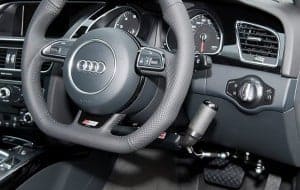In this day and age, travelingby automobile is virtually a necessity for the majority of American adults. Most of us use our cars daily to commute to and from work, to go shopping and complete other chores, to chauffeur our children to their activities, to visit our friends and family members, or merely to get away for relaxation or vacation.
And the good news is that modern technology has offered people with physical impairments, who might not believe they can navigate a car safely, the opportunity to remain independent and mobile. Almost every automobile manufacturer, as well as a vast number of after-market product suppliers, has created a wide variety of automobile adaptations that can place almost every impaired, disabled, or mobility-challenged adult behind the wheel and on the road.
For example, pedal adaptations are available for individuals who have lost the use of their right leg and cannot utilize the standard accelerator. Left foot accelerators can be fitted to the left of the brake so that accelerating with the left foot becomes possible. For individuals who cannot reach the pedals at all when driving, pedal extenders can bring them closer to the driving seat.
For individuals who have lost the use of both legs, there are many ways in which a car’s traditional pedal functions – braking and accelerating – can be accomplished with hand controls. Push-pull hand controls allow the driver to operate the brake and accelerator functions by pushing and pulling a lever. There are various hand controls available from most manufacturers and suppliers, but the basic function is the same across most models. They range from more basic mechanical push/pull systems to electronic or air compression systems. Most can be fitted with “cutting” devices which automatically cut the accelerator when the brake is applied. And some can even be mounted on different locations inside the car. Some variations of the electronic hand control system include:
• The Trigger Accelerator – With a trigger accelerator you pull with your finger to accelerate, and push away to brake.
• The Over Ring Accelerator – The over ring accelerator is fitted in front of the steering wheel. You push it down toward the steering wheel to accelerate.
• The Under Ring Accelerator – The under ring accelerator is fitted behind the steering wheel. You pull it towards the steering wheel to accelerate.
• The Ghost Ring Accelerator – The ghost ring accelerator is fitted behind the steering wheel. You control the speed by using your fingers in side to side movements.
• The Twist Grip Accelerator – The twist grip accelerator is comparable to the hand grip accelerator on a motorbike. You twist it to accelerate and push it forward to operate the brake.
The bottom line is this: there is absolutely no reason for a disabled, but otherwise competent, adult to believe that he or she cannot safely operate an automobile. Here at Pacific Mobility, we can help you choose the most appropriate driving adaptation to meet your needs. Call or visit us today and allow our mobility experts to get you into the driver’s seat.
President, Husband, Father, Grandfather Graduate of UC Davis- Bio Sci Major- Go Aggies! Jeff has extensive experience in all of Pacific Mobility’s products and services, and specializes in accessibility products as well as stairlifts, ceiling lifts and custom wheel chairs. His hobbies include spending time with family, gardening, mountain biking, exercising and off road motorcycle riding.
24 years as Owner/President of Pacific Mobility Center – selling, installing, and servicing stairlifts, porch lifts, ceiling lifts, pool lifts, handicap ramping, specialty wheelchairs, scooters, power wheel chairs, and other power mobility devices
Certified Environmental Access Consultant since 2008
Licensed General Contractor since 1998
Certified Aging in Place Specialist since 2016
Board Member for Home Access Professionals
Member of Association of Members of the Accessibility Equipment Industry (AEMA)




